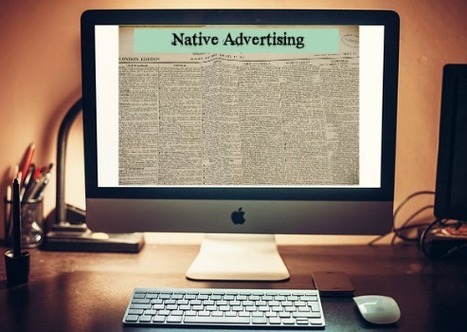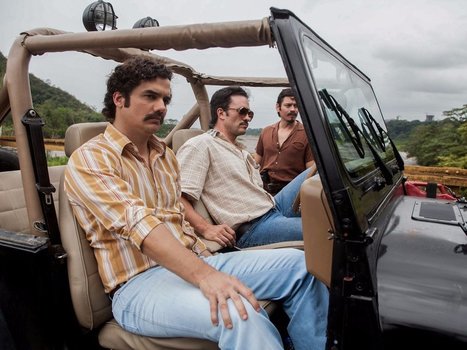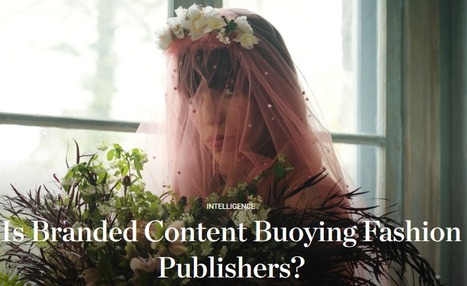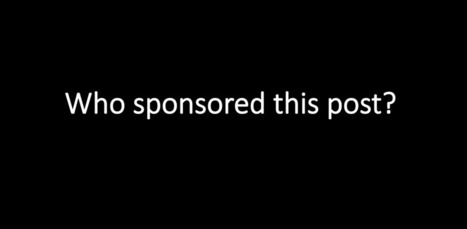 Your new post is loading...
 Your new post is loading...
Quality storytelling and narrative matter more than ever, and must be first and foremost in your mind when approaching “branded” content. The quotes are intentional. It is an opportune time to drop the word “branded” from that phrase and from your vocabulary. Content is content. Good content is good content. If a story is moving, no one is going to care that it’s brought to you by a brand. Rather, they’re going to be happy the brand brought it to them. And by the same token, content that is annoying is now amplified rather than ignored (because no one can resist a good call-out) and can be more harmful to a brand than ever....
The nonprofit Online Trust Alliance (OTA) on Wednesday conducted a study that found 71% of native ads on top media sites fail to offer adequate labeling, transparency, and complete consumer disclosure.
This is a blow to the native ad/branded content business and should be a wake-up call for publishers and content studios.
The study, an analysis of native ads on the top 100 news websites, found that 71% earned failing scores for disclosures, delineation, and discoverability. The bottom line: The sites didn’t offer consumers the ability to easily discern pure editorial from ads.
As most readers of this column know, native advertising refers to Web site content that’s funded and produced outside the publisher’s editorial review or influence, yet is designed to appear similar to editorial on that site. As the OTA mentions, “this illustrates the tension -- paid for and controlled separately, but presented in a way to appear as editorial. The potential for audience confusion or misinterpretation is obvious, and the rapid rise in the deployment of native has already prompted concerns from advocates, media and regulators.”...
“While the industry looks at native advertising as the holy grail to drive new revenues, they are failing to address the long-term issue. With 71% of native ads failing to pass the consumer transparency acid test, this report should be a wake-up call to the industry. Inaction is not an option. Conversely, providing these concrete examples and recommendations helps advertisers, networks and publishers in moving forward,” Craig Spiezle, executive director at the Online Trust Alliance, told Native Insider via email.
Have you been thinking about turning your organization's communications into your version of a metropolitan newspaper newsroom? Here are some examples you should look at.
Most online publishers use some form of native advertising — ads that look like news stories — to grow revenue. It is accepted practice to declare that this content is sponsored by a company, so that readers can differentiate between what is and is not news. However, the way in which many publishers declare these ads could be "complicit with deception," according to a new study by Bart Wojdynski, director of the digital media, attention, and cognition lab at the University of Georgia.Wojdynski and Nathaniel J. Evans, assistant professor in advertising at the same university, led the study, which found that 60% of readers did not notice the sponsor disclosure label placed at the top of sponsored articles. It also showed that readers are seven times more likely to recognize the labels that use some form of the words "advertising" or “sponsored,” than those which use more vague phrases like “brand voice” or “presented by.” Overall, only 20% of people in the study were aware that they were reading advertising, rather than objective, editorial content....
To say native content has grown since last year would be an understatement. In 2014, Pressboard combed through 1,500 pieces of content for our "best of" list -- this year it was closer to 7,000. To give you an idea of how far the space has come, we had to buy VR headsets just to review a couple of the entries.
2015 was the year that native content moved from experimental to fundamental and nearly every major publisher and brand discovered the power of stories, instead of ads. Here are some of the best from the last 12 months...
In the startup world, we hear a lot of talk about the Web and digital media “disrupting” traditional business models in a positive sense. But one rather important old-school industry, journalism, has found its lot in the digital frontier to be a pretty unhappy one. Newspaper subscription rates have plummeted, and only a select few publications have managed to successfully monetize their online content.
Many people have proclaimed multimedia to be the solution to this issue. The logic is that, if you could seamlessly integrate beautiful photographs, graphics, audio and even video into your articles, then you’d have yourself a truly viable product for digital natives.So it became a design problem. And, in late December of 2012, The New York Times may have solved it...
|
Polar tested different ad formats including image-based content (graphics, image galleries, and slide shows), article-based content, and video-based content. It tested more than 30 pieces of content, with each type tested by a minimum of 1,000 people via desktop, mobile, and both. Among the findings of the study, conducted in March 2017: --Consumer awareness of a brand increased to 69% after engaging with branded content, while purchase intent was 51%. The study also used a control group with no branding. --Incorporating companion display ads next to branded content improved purchase intent by 17% and didn’t have a negative impact on brand perception --Imagery (infographics, image galleries, and slide shows) performed the best among content formats. And notably, video isn’t always needed to tell the story. However, imagery outperformed articles by 11%. "We found that consumers responded a bit more favorably when there was less obvious branding,” Bella said....
Therefore, content creators and advertisers may find themselves scratching their heads about how to break through the clutter with compelling branded content that attracts an audience and makes them want more. “While there’s no ‘one size fits all’ when it comes to creating impactful branded content, we’ve identified some common themes in our research and content testing that can be used as best practices for making content resonate with audiences,” said Harry Brisson, Director of Lab Research at Nielsen. To better understand how consumers are reacting to this new form of marketing content, Nielsen assessed consumer reactions to more than 100 pieces of branded content and found that a brand’s effectiveness (e.g., how a brand resonates with viewers) is largely affected by the format and environment the message is delivered in. The results of the analysis uncovered three key takeaways that can help brands deliver strong content that resonates with and builds audiences: - Branded content can drive higher brand recall and brand lift than pre-roll - When viewers enjoy content, they view the integrated brands more favorably - Partnering with a publisher can drive ad impact....
On Monday, Gucci will release its latest fashion film, a Gia Coppola-directed spin on the tragic Greek love story of Orpheus and Eurydice, set in present-day New York City and starring Lou Doillon, Marcel Castenmiller, Laura Love, Rocco Di Gregorio, among others. Coppola and stylist Arianne Phillips worked in tandem with Alessandro Michele to capture the dreamy feel of the hot-shot creative director’s Pre-Fall 2016 collection, which the film — shot across five locations and broken into four episodes — was created to promote. Michele even designed a custom pink 10-foot long wedding veil for Doillon’s character.
But while shorts like these are nothing new, the genesis of the film was fairly unorthodox. Instead of tapping its internal marketing team or a traditional agency, Gucci worked with 23 Stories, the branded-content studio launched in January 2015 by publishing giant Condé Nast. Beyond Gucci’s own marketing channels, the film will be distributed through six Condé Nast (US) properties — Vogue, GQ, the New Yorker, W, Vanity Fair and Pitchfork — which, together, attracted a total of about 32 million unique visitors in April 2016, according to Comscore. Beyond their URLs, those six publications boast a cumulative social media following of nearly 67 million. The film will also be promoted via Vogue China and Vogue Japan. Gucci and Condé Nast suggest the project is bigger and more ambitious than anything else either party has previously done in the branded-content space, both in terms of the level of talent recruited and also the scale of the production.
To be sure, the Kering-owned Italian luxury house has the resources and capacity to create video content like this on its own. But Gucci is after Condé Nast’s larger, and presumably more diverse, audience. For instance, Gucci has 8.8 million followers on Instagram while these six titles combined have about 18.5 million. In this deal, Pitchfork’s millennial male followers — an important demographic for Gucci under Michele — are as crucial to the equation as W’s affluent luxury consumer....
Therein lies the problem: native advertising is more effective because it masquerades as actual content. But it’s illegal to pass advertising messages off as editorial content. The Advertising Standards Authority in the United Kingdom, for instance, banned a native YouTube ad sponsored by Oreo that featured two well known video bloggers because the agency felt it was not clearly identified as marketing communication.
Stateside, the Federal Trade Commission (“FTC”) has long waged war on false advertising—marketing or advertising communications that tend to mislead consumers. Recently, the FTC issued an “enforcement policy statement on deceptively formatted advertisements” giving advertisers and publishers alike a heads up: deceptive native ads will not be tolerated.
So how can your brand capitalize on native advertising without breaking the law? The FTC offers some insight in their guide, “Native Advertising: A Guide for Businesses.”...
...As the traditional journalism business continues to implode, journalism educators need to be thinking a lot more about the second category, but also in broader ways about the first. If we recognize journalism in places where we never used to acknowledge its existence, journalism programs will discover niches that could fuel new programs and attract new students.
Here’s one: In 2009, I suggested that some advocacy organizations were creating “almost-journalism” — doing deep and valuable reporting on issues that mattered, such as civil liberties, human rights and more. They could do even better, I said, if they applied basic journalistic principles — because they’d be even more credible.
Earlier this week, Coca-Cola declared the corporate website dead.
Take one quick look at their new corporate website and I think you will see an example of the future of quality content marketing. They are clearly displaying how the art of storytelling not only can influence our preference for a brand or product, but surely their intent is to also reach a search engine position of respect and power....
|



 Your new post is loading...
Your new post is loading...





















If a story is moving, no one is going to care that it’s brought to you by a brand—they’re going to be happy the brand brought it to them.